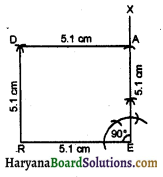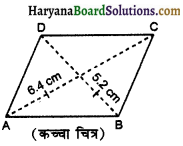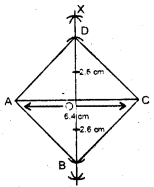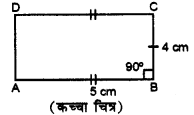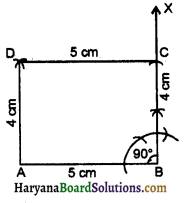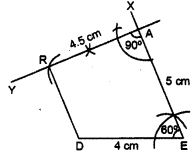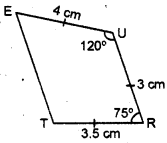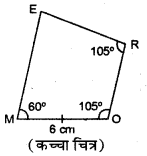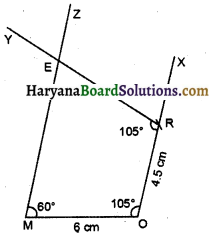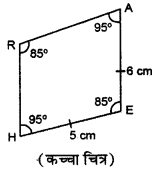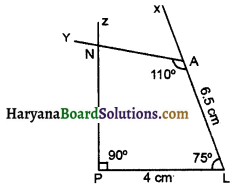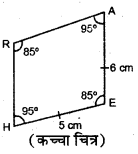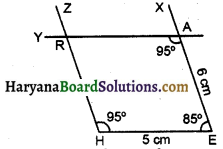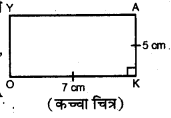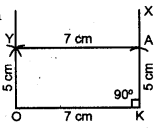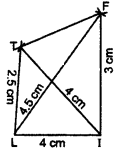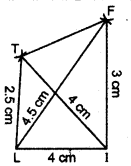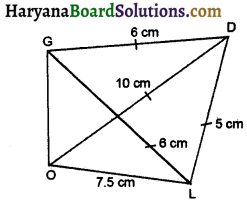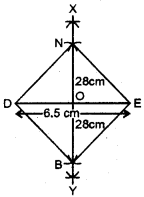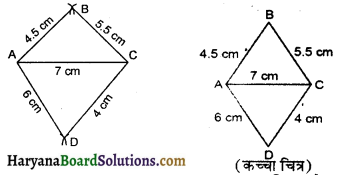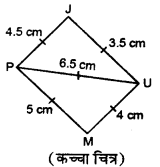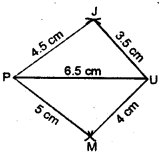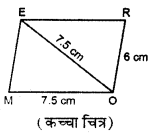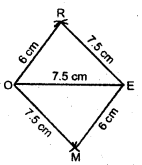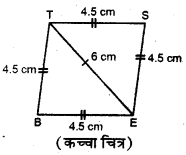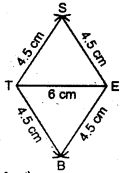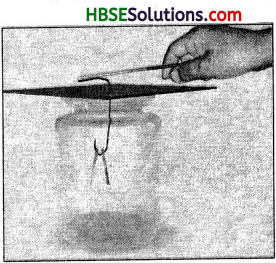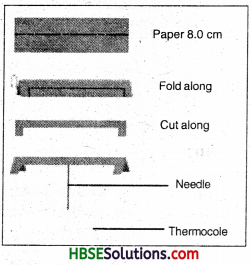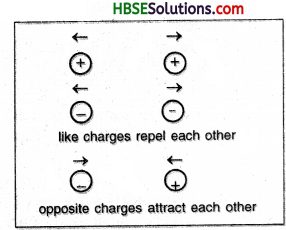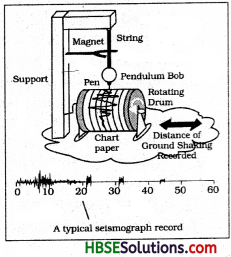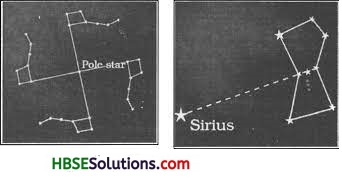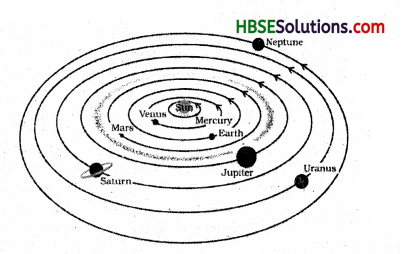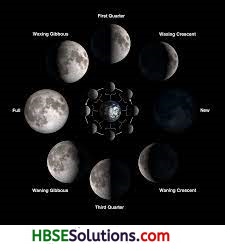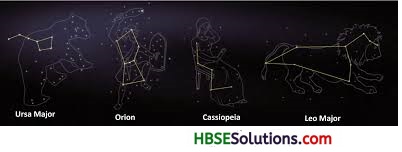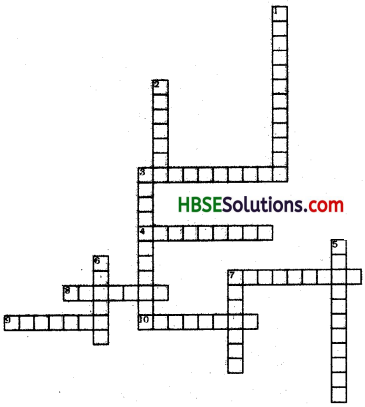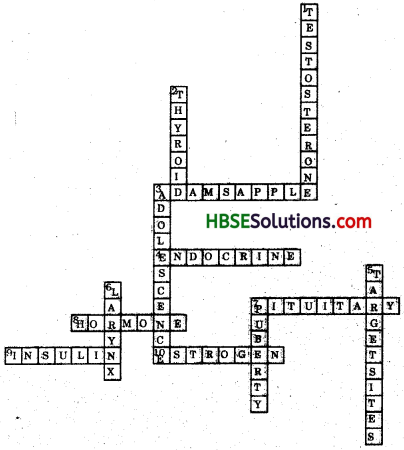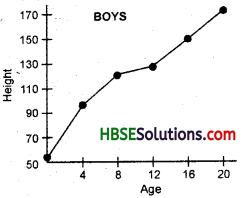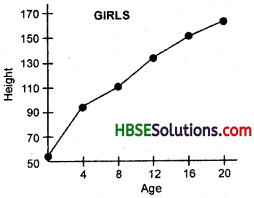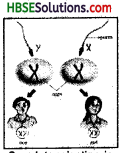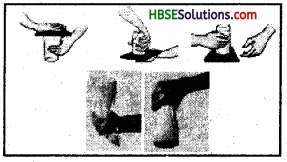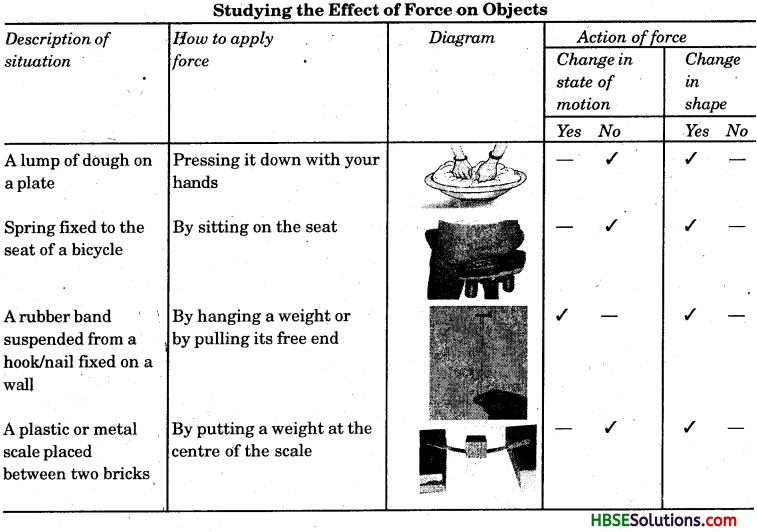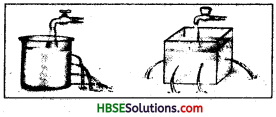HBSE 8th Class Maths Solutions Chapter 6 वर्ग और वर्गमूल Intext Questions
Haryana State Board HBSE 8th Class Maths Solutions Chapter 6 वर्ग और वर्गमूल Intext Questions and Answers.
Haryana Board 8th Class Maths Solutions Chapter 6 वर्ग और वर्गमूल Intext Questions
(प्रयास कीजिए – पृष्ठ 96)
प्रश्न 1.
दी गई संख्याओं के बीच की पूर्ण वर्ग संख्याएँ ज्ञात कीजिए-
(i) 30 और 40
(ii) 50 और 60
हल:
5 × 5 = 25, 6 × 6 = 36, 7 × 7 = 49 और 8 × 8 = 64
∴ 30 और 40 के बीच की पूर्ण संख्या 36 है।
(ii) 50 और 60 के बीच की पूर्ण वर्ग संख्या नहीं है।
पृष्ठ 97
प्रश्न 1.
क्या हम कह सकते हैं कि निम्न संख्याएँ पूर्ण वर्ग संख्याएँ हैं? हम कैसे जानते हैं?
(i) 1057
(ii) 23453
(iii) 7928
(iv) 222222
(v) 1069
(vi) 2061
पाँच ऐसी संख्याएँ लिखिए जिनके इकाई स्थान को देखकर आप बता सकें कि ये संख्याएँ वर्ग संख्याएँ नहीं हैं।
(i) 1057 – चूँकि इकाई स्थान का अंक 0, 1, 4, 5, 6 या 9 नहीं है। अतः यह पूर्ण वर्ग संख्या नहीं है।
(ii) 23453 – चूँकिे इकाई स्थान पर 0, 1, 4, 5, 6 या 9 नहीं है। अतः यह पूर्ण वर्ग संख्या नहीं है।
(iii) 7928 – चूँकि इकाई स्थान पर 0, 1, 4, 5, 6 या 9 नहीं है। अतः यह पूर्ण वर्ग संख्या नहीं हो सकती है।
(iv) 222222 – चूँकि इकाई के स्थान पर 0, 1, 4, 5, 6 या 9 नहीं है। अतः यह पूर्ण वर्ग संख्या नहीं हो सकती है।
(v) 1069 – चूँकि इकाई स्थान पर 9 है। अतः यह पूर्ण वर्ग संख्या हो सकती है और नहीं भी हो सकती है।
अब
322 = 32 × 32 = 1024
और 332 = 33 × 33 = 1089
अतः 1069 एक पूर्ण वर्ग संख्या नहीं है।
(vi) 2061 – इकाई के स्थान पर 1 है। अतः यह संख्या पूर्ण वर्ग संख्या भी हो सकती है और नहीं भी हो सकती है।
लेकिन 452 = 45 × 45 = 2025
और 462 = 46 × 46 = 2116
अतः 2061 एक पूर्ण वर्ग संख्या नहीं है।
पाँच संख्याएँ जिनके इकाई स्थान को देखकर हम पता कर सकते हैं कि ये वर्ग संख्याएँ नहीं हैं, वे हैं 22, 33, 47, 58 और 68.
![]()
प्रश्न 2.
पाँच ऐसी संख्याएँ लिखिए जिनके इकाई स्थान को देखकर आप नहीं बता सकते कि वे वर्ग संख्याएँ हैं या नहीं?
हल:
ऐसी पाँच संख्याएँ जिनके इकाई स्थान को देखकर हम नहीं बता सकते कि ये वर्ग संख्याएँ हैं या नहीं, वे हैं-
1000, 1001, 2004, 30015, 74566
(प्रयास कीजिए – पृष्ठ 97)
प्रश्न 1.
1232,772,822, 1612, 1092 में से कौनसी संख्या अंक 1 पर समाप्त होगी?
हल:
यदि संख्या के इकाई संख्याएँ का अंक 1 और 9 है, तो इनके वर्ग 1 पर समाप्त होते हैं। अतः संख्याएँ 1612 और 1092 के अंक एक पर समाप्त होंगे।
(प्रयास कीजिए – पृष्ठ 98)
प्रश्न 1.
निम्नलिखित में से कौनसी संख्याओं के इकाई स्थान पर 6 अंक होगा
(i) 192
(ii) 242
(iii) 262
(iv) 362
(v) 342
हल:
जिस संख्या का इकाई अंक 4 या 6 होता है, उस संख्या के वर्ग इकाई स्थान पर 6 अंक होता है।
अतः 24, 26, 36, तथा 34 के इकाई स्थान पर 6 आएगा।
![]()
(प्रयास कीजिए – पृष्ठ 98)
प्रश्न 1.
निम्नलिखित संख्याओं के वर्ग करने पर उनके इकाई स्थान पर क्या होगा?
(i) 1234
(ii) 26387
(iii) 52698
(iv) 99880
(v) 21222
(vi) 9106
हल:
| क्र.सं. | संख्या | वर्ग करने पर उनके इकाई स्थान पर | संकेत |
| (i) | 1234 | 6 | 4 × 4 = 16 |
| (ii) | 26387 | 9 | 7 × 7 = 49 |
| (iii) | 52698 | 4 | 8 × 8 = 64 |
| (iv) | 99880 | 0 | 0 × 0 = 0 |
| (v) | 21222 | 4 | 2 × 2 = 4 |
| (vi) | 9106 | 6 | 6 × 6 = 36 |
(प्रयास कीजिए – पृष्ठ 98)
प्रश्न 1.
निम्नलिखित में से किन संख्याओं के वर्ग विषम संख्या/सम संख्या होंगे? क्यों?
(i) 727
(ii) 158
(iii) 269
(iv) 1980
हल:
(i) 727 एक विषम संख्या है, इसलिए इसका वर्ग भी विषम संख्या होगी।
(ii) 158 एक सम संख्या है। इसलिए इसका वर्ग भी सम संख्या होगी।
(iii) 269 एक विषम संख्या है। इसलिए इसका वर्ग भी विषम संख्या होगी।
(iv) 1980 एक सम संख्या है। इसलिए इसका वर्ग भी सम संख्या होगी।
प्रश्न 2.
निम्नलिखित संख्याओं के वर्ग में शून्यों की संख्या क्या होगी?
(i) 60
(ii) 400
हल:
(i) 60 दो शून्य
(ii) 400 चार शून्य
![]()
(प्रयास कीजिए – पृष्ठ 100)
प्रश्न 1.
92 और 102 के बीच कितनी प्राकृत संख्याएँ हैं?
112 और 122 के बीच भी प्राकृत संख्याओं की संख्या बताइए।
हल:
92 और 102 के बीच प्राकृत संख्याएँ 2n होंगी, जबकि n = 9 होगा।
अतः 2 × 9 = 18 प्राकृत संख्याएँ हैं।
इसी प्रकार 112 और 122 के बीच 2 × 11 = 22 प्राकृत संख्याएँ हैं।
प्रश्न 2.
निम्नलिखित संख्याओं के यग्मों के बीच की संख्या बताइए जो वर्ग संख्याएँ नहीं हैं।
(i) 1002 और 1012
(ii) 902 और 912
(iii) 10002 और 10012
हल:
(i) 1002 और 1012 के बीच 2n = 2 × 100 = 200 संख्याएँ हैं, जो वर्ग संख्याएँ नहीं हैं।
(ii) 902 और 912के बीच 2n = 2 × 90 = 180 संख्याएँ हैं, जो वर्ग संख्याएँ नहीं हैं।
(iii) 10002 और 10012 के बीच 2n = 2 × 1000 = 2000 संख्याएँ हैं, जो वर्ग संख्याएँ नहीं हैं।
(प्रयास कीजिए – पृष्ठ 101)
प्रश्न 1.
निम्नलिखित संख्याओं में प्रत्येक पूर्ण वर्ग संख्याएँ हैं अथवा नहीं?
(i) 121
(ii) 55
(iii) 81
(iv) 49
(v) 69
हल:
(i) 121
पहली n विषम प्राकृत संख्याओं का योग n2 होता है, चूंकि उक्त संख्याओं में से 1,3,5,7,9,……… को क्रम से घटाते हैं।
121 – 1 = 120, 120 – 3 = 117, 117 – 5 = 112, 112 – 7 = 105, 105 – 93 = 96, 96 – 11 = 85, 85 – 13 = 72, 72 – 15 = 57, 57 – 17 = 40, 40 –19 = 21, 21 – 21 = 0
अर्थात् यहाँ 121 = 1 + 3 + 5 + 7 + 9 + 11 + 13 + 15 + 17 + 19 + 21
अतः 121 एक पूर्ण वर्ग संख्या है।
(ii) 55
55 – 1 = 54, 54 – 3 = 51, 51 – 5 = 46, 46 – 7 = 39, 39 – 9 = 30, 30 – 11 = 19, 19 – 13 = 6, 6 – 6, 6 – 15 = -9
∵ 55 से 1 प्रारम्भ होने वाली विषम संख्याओं का योग नहीं है।
∴ 55 एक पूर्ण वर्ग संख्या नहीं है।।
(iii) 81
81 – 1 = 80, 80 – 3 = 77, 77 – 5 = 72, 72 – 7 = 65, 65 – 9 = 56, 56 – 11 = 45, 45 – 13 = 32, 32 – 15 = 17, 17 – 17 = 0
अर्थात् यहाँ 81 = 1+ 3 +5 +7+9+ 11+ 13 + 15 + 17
∴ 81 एक पूर्ण वर्ग संख्या है।
(iv) 49
49 – 1 = 48, 48 – 3 = 45, 45 – 5 = 40, 40 – 7 = 33, 33 – 9 = 24, 24 – 11 = 13, 13 – 13 = 0
अर्थात् यहाँ 49 = 1 + 3 + 5 + 7 + 9 + 11 + 13
∴ 49 एक पूर्ण वर्ग संख्या है।
(v) 69
69 – 1 = 68, 68 – 3 = 65, 65 – 5 = 60, 60 – 7 = 53, 53 – 9 = 44, 44 – 11 = 33, 33 – 13 = 20, 20 – 17 = 3, 3 – 1
∵ 69 से 1 प्रारम्भ होने वाली विषम संख्याओं का योग नहीं है।
∴ 69 एक पूर्ण वर्ग संख्या नहीं है।
![]()
(प्रयास कीजिए – पृष्ठ 101)
प्रश्न 1.
निम्नलिखित संख्याओं को दो क्रमागत पूर्णांकों के योग के रूप में लिखिए
(i) 212
(ii) 132
(iii) 112
(iv) 192
हल:
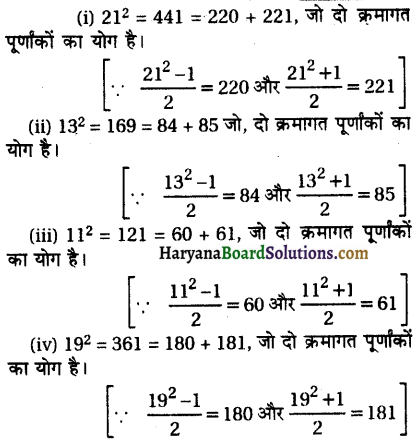
प्रश्न 2.
क्या आप सोचते हैं कि इसका विलोम सत्य है अर्थात् क्या दो क्रमागत धनात्मक पूर्णांकों का योग एक पूर्ण वर्ग होता है? अपने उत्तर के पक्ष में एक उदाहरण दीजिए।
हल:
दो क्रमागत धनात्मक पूर्णांकों का योग सदैव एक पूर्ण वर्ग नहीं होता है।
उदाहरण: 10 + 11 = 21
यहाँ 10 + 11 क्रमागत धनात्मक पूर्णांक हैं, परन्तु इनका योग पूर्ण वर्ग संख्याएँ नहीं है।
![]()
(प्रयास कीजिए – पृष्ठ 102)
प्रश्न 1.
निम्न प्रतिरूप का उपयोग करते हुए नीचे दी गई संख्याओं की वर्ग संख्याएँ लिखिए

(i) 1111112
(ii) 11111112
हल:
(i) 1111112 = 1 2 3 4 5 6 5 4 3 2 1
(ii) 11111112 = 1 2 3 4 5 6 7 6 5 4 3 2 1
प्रश्न 2.
दिए गए प्रतिरूप का उपयोग करते हुए क्या आप निम्नलिखित संख्याओं का वर्ग ज्ञात कर सकते हैं?
(i) 66666672
(ii) 666666672
प्रतिरूप-
72 = 49
672 = 4489
6672 = 444889
66672 = 44448889
666672 = 4444488889
6666672 = 444444888889
हल:
(i) 66666672 = 44444448888889
(ii) 666666672 = 4444444488888889
![]()
(प्रयास कीजिए – पृष्ठ 104)
प्रश्न 1.
निम्नलिखित संख्याओं के वर्ग ज्ञात कीजिए जिनके इकाई अंक 5 हैं
(i) 15
(ii) 95
(iii) 105
(iv) 205
हल:
(i) 152 = (1 × 2) सौकाई + 25
= 200 + 25 = 225
(ii) 95
952 = (9 × 10) सौकाई + 25
= 9000 + 25 = 9025
(iii) 105
1052 = (10 × 11) सौकाई + 25.
= 11000 + 25 = 11025
(iv) 205
2052 = (20 × 21) सौकाई + 25
= 42000 + 25 = 42025
(प्रयास कीजिए – पृष्ठ 106)
प्रश्न 1.
(i) 112 = 121, 121 का वर्गमल क्या है?
(ii) 142 = 196, 196 का वर्गमूल क्या है?
हल:
(i) 121 का वर्गमूल 11 है।
(ii) 196 का वर्गमूल 14 है।
![]()
(सोचिए, चर्चा कीजिए और लिखिए – पृष्ठ 106)
प्रश्न 1.
(-1)2 = 1. क्या 1 का वर्गमूल है -1?
हल:
1 का वर्गमूल -1 तथा 1 होते है।
अत: 1 का वर्गमूल -1 भी होगा।
प्रश्न 2.
(-2)2 = 4, क्या 4 का वर्गमूल है -2?
हल:
4 का वर्गमूल -2 भी है।
प्रश्न 3.
(-9)2 = 81. क्या 81 का वर्गमूल है – 9?
हल:
81 का वर्गमूल -9 भी है।
![]()
(प्रयास कीजिए – पृष्ठ 107)
प्रश्न 1.
से प्रारम्भ होने वाली विषम संख्याओं को बारबार घटाने पर प्राप्त निम्नलिखित संख्याएँ पूर्ण वर्ग हैं या नहीं? यदि यह संख्या पूर्ण वर्ग है तो इसके वर्गमूल ज्ञात कीजिए।
(i) 121
(ii) 55
(iii) 36
(iv) 49
(v) 90
हल:
(i) पूर्ण वर्ग की जाँच करने के लिए 121 में से हम क्रमशः 1 से प्रारम्भ होने वाली विषम संख्याओं को घटाने पर,
121 – 1 = 120
120 – 3 = 117
117 – 5 = 112
112 – 7 = 105
105 – 9 = 96
95 – 11 = 85
85 – 13 = 72
72 – 15 = 57
57 – 17 = 40
40 – 19 = 21
21 – 21 = 0
संख्या 1 से क्रमागत विषम संख्याओं को 121 में से 11 वाँ पद घटाने पर 0 प्राप्त होता है। अत: \(\sqrt{121}\) = 11.
(ii) पूर्ण वर्ग की जाँच करने के लिए 55 में से हम क्रमशः 1 से प्रारम्भ होने वाली विषम संख्याओं को घटाने पर,
55 – 1 = 54
54 – 3 = 51
51 – 5 = 46
46 – 7 = 39
39 – 9 = 30
30 – 11 = 19
19 – 13 = 6,
6 – 15 = -9
∵ 55 को संख्या 1 से क्रमागत विषम संख्याओं से पूर्णत: नहीं हटाया जा सकता है।
∴ 55 एक पूर्ण वर्ग नहीं है।।
(iii) पूर्ण वर्ग की जाँच करने के लिए 36 में से हम क्रमशः 1 से प्रारम्भ होने वाली विषम संख्याओं को घटाएँगे,
36 – 1 = 35
35 – 3 = 32
32 – 5 = 27
27 – 7 = 20
20 – 9 = 11
11 – 11 = 0
अत: 36 पूर्ण वर्ग है और \(\sqrt{36}\) = 6.
(iv) पूर्ण वर्ग की जाँच करने के लिए 49 में से हम क्रमशः 1 से प्रारम्भ होने वाली विषम संख्याओं को घटाएँगे,
49 – 1 = 48
48 – 3 = 45
45 – 5 = 40
40 – 7 = 33
33 – 9 = 24
24 – 11 = 13
13 – 13 = 0
अत: 36 पूर्ण वर्ग है और \(\sqrt{49}\) = 7.
(v) पूर्ण वर्ग की जाँच करने के लिए 90 में से हम क्रमशः 1 से प्रारम्भ होने वाली विषम संख्याओं को घटाएँगे,
90 – 1 = 89
89 – 3 = 86
86 – 5 = 81
81 – 7 = 74
74 – 9 = 65
65 – 11 = 54
54 – 13 = 41
41 – 15 = 26
26 – 17 = 9
9 – 19 = -10
∴ 90 एक पूर्ण वर्ग नहीं है।
![]()
(सोचिए, चर्चा कीजिए और लिखिए – पृष्ठ 111)
प्रश्न 1.
क्या हम कह सकते हैं कि एक पूर्ण वर्ग संख्या में यदि n अंक है तो उसके वर्गमूल में \(\frac{n}{2}\), अंक होंगे। यदि n सम है या \(\frac{(n + 1)}{2}\) होंगे यदि n विषम है?
हल:
हाँ, हम कह सकते हैं कि यदि एक पूर्ण वर्ग संख्या में n अंक है, तो इसके वर्गमूल में यदि n अंक है, तो उसके वर्गमूल में
(i) \(\frac{n}{2}\) अंक होंगे, यदि n सम है तथा
(ii) \(\frac{(n + 1)}{2}\) अंक होंगे, यदि n विषम है।
उदाहरण-
(i) सम संख्या \(\sqrt{16}\) = 4, \(\sqrt{2500}\) = 50 आदि
(ii) सम संख्या \(\sqrt{9}\) = 3, \(\sqrt{100}\) = 10 आदि
(प्रयास कीजिए – पृष्ठ 112)
प्रश्न 1.
निम्नलिखित संख्याओं के वर्गमूल में अंकों की संख्या को गणना के बिना ज्ञात कीजिए
(i) 25600
(ii) 100000000
(iii) 36864
हल:
(i) ∵ 25600 में 5 अंक हैं, अतः \(\sqrt{25600}\) में = \(\frac{(n+1)}{2}\) = \(\frac{(5+1)}{2}\) = 3 अंक होंगे।
(ii) ∵ 100000000 में 9 अंक हैं, अतः \(\sqrt{100000000}\) में = \(\frac{(n+1)}{2}\) = \(\frac{(9+1)}{2}\) = 5 अंक होंगे।
(iii) ∵ 36864 में 5 अंक हैं, अतः \(\sqrt{36864}\) में = \(\frac{(5+1)}{2}\) = 3 अंक होंगे।
![]()
(प्रयास कीजिए – पृष्ठ 115)
प्रश्न 1.
निम्नलिखित संख्याओं के निकटतम पूर्ण संख्याओं का अनुमान लगाइए
(i) \(\sqrt {80}\)
(ii) \(\sqrt {1000}\)
(iii) \(\sqrt {350}\)
(iv) \(\sqrt {500}\)
हल:
(i) ∵ \(\sqrt {64}\) < \(\sqrt {80}\) < \(\sqrt {81}\)
⇒ 8 < \(\sqrt {80}\) < 9
∵ 81, 64 की अपेक्षा 80 के अधिक नजदीक है।
\(\sqrt {80}\) की निकटतम पूर्ण संख्या 9 है।
(ii) \(\sqrt {1000}\)
∵ \(\sqrt {961}\) < \(\sqrt {1000}\) < \(\sqrt {1024}\)
⇒ 31 < \(\sqrt {1000}\) < 32
∵ 1024, 961 की अपेक्षा 1000 के अधिक नजदीक है।
∴ \(\sqrt {1000}\) की निकटतम पूर्ण संख्या 32 है।
(iii) \(\sqrt {350}\)
∵ \(\sqrt {961}\) < \(\sqrt {350}\) < \(\sqrt {1024}\)
⇒ 18 < \(\sqrt {350}\) < 19
∵ 361, 324 की अपेक्षा 350 के अधिक नजदीक है।
∴ \(\sqrt {350}\) की निकटतम पूर्ण संख्या 19 है।
(iv) \(\sqrt {500}\)
∵ \(\sqrt {484}\) < \(\sqrt {500}\) < \(\sqrt {529}\)
⇒ 22 < \(\sqrt {500}\) < 23
∵ 484, 529 की अपेक्षा 500 के अधिक नजदीक है।
∴ \(\sqrt {500}\) की निकटतम पूर्ण संख्या 22 है।
